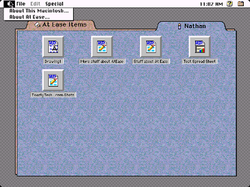At Ease for Workgroups
At Ease for Workgroups allows users to log on to a server from any workstation that has the At Ease software installed. At Ease for Workgroups introduced a number of network-specific features not found in the original At Ease. The workgroup version enabled client configuration, network access and restrictions on how the client's computer can be used. In addition to the beige-colored Applications "folder" and the blue-colored Documents "folder" that each user had in his or her workspace, the workgroup version of the software also allowed for easier access to removable media: a pink-colored folder would appear in the user's profile for any CD-ROM inserted into the computer and a green-colored folder would appear for a floppy disk. These features were controlled for each user by the administrator. At Ease for Workgroups also included an Administration program to add users and workgroups to the network.
At Ease for Workgroups 5 also provided a restricted Finder mode that allowed the Finder to operate instead of the traditional At Ease panels. It provided quick access to the user's documents folder which could be stored on an AppleShare IP server. The restricted Finder mode later evolved into Mac OS 9's multiple users feature.
Starting with version 4.0, At Ease was sold as part of the Apple Network Administrator Toolkit (ANAT), [3] which additionally included Apple Network Assistant and Apple User and Group Manager. [4] [5]
Features brought into Mac OS 9
Built-in support for multiple users was implemented in Mac OS 9, bringing all of the features straight into the Mac OS and thus eliminating the need to install and use a different environment.
Even though At Ease was discontinued, certain aspects of its user interface appear in later versions of Mac OS. Its influence upon iOS, Apple's operating system for iPhone and iPad devices, has been noted. [6] There is also a similarity to the Launcher control panel in Mac OS 7 and 8. [7] In macOS, the Simple Finder is very similar to the idea of At Ease. [8]
This page is based on this
Wikipedia article Text is available under the
CC BY-SA 4.0 license; additional terms may apply.
Images, videos and audio are available under their respective licenses.
